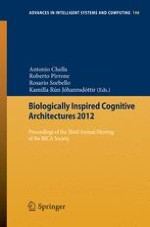2013 | OriginalPaper | Buchkapitel
Odor Perception through Network Self-organization: Large Scale Realistic Simulations of the Olfactory Bulb
verfasst von : Michele Migliore
Erschienen in: Biologically Inspired Cognitive Architectures 2012
Verlag: Springer Berlin Heidelberg
Aktivieren Sie unsere intelligente Suche, um passende Fachinhalte oder Patente zu finden.
Wählen Sie Textabschnitte aus um mit Künstlicher Intelligenz passenden Patente zu finden. powered by
Markieren Sie Textabschnitte, um KI-gestützt weitere passende Inhalte zu finden. powered by
Analysis of the neural basis for odor recognition may have significant impact not only for a better explanation of physiological and behavioral olfactory processes, but also for industrial applications in the development of odor-sensitive devices and applications to the fragrance industry. While the underlying mechanisms are still unknown, experimental findings have given important clues at the level of the activation patterns in the olfactory glomerular layer by comparing the responses to single odors and to mixtures. The processing rules supporting odor perception are controversial. A point of general importance in sensory physiology is whether sensory activity is analytic (or elemental) or synthetic (or configural). Analytic refers to the perception of individual components in a mixture, whereas synthetic refers to the creation of a unified percept. An example of analytic perception is taste in that sweet and sour can be combined in a dish and tasted individually. The mixture of blue and yellow to make green is an example of synthetic perception in vision. Which one of these properties applies to any given odor mixture is unclear and often confusing. In recent papers this problem has been intensely investigated experimentally but the underlying computational and functional processes are still poorly understood. The main reason is that the practical impossibility of recording simultaneously from a reasonable set of cells makes it nearly impossible to decipher and understand the emergent properties and behavior of the olfactory bulb network. We addressed this problem using a biological inspired cognitive architecture: a large-scale realistic model of the olfactory bulb. We directly used experimental imaging data on the activation of 74 glomeruli by 72 odors from 12 homologous series of chemically related molecules to drive a biophysical model of 500 mitral cells and 10,000 granule cells (1/100th of the real system), to analyze the operations of the olfactory bulb circuits. The model demonstrates how lateral inhibition modulates the evolving dynamics of the olfactory bulb network, generating mitral and granule cell responses that support/explain several experimental findings, and suggests how odor identity can be represented by a combination of temporal and spatial patterns, with both feedforward excitation and lateral inhibition via dendrodendric synapses as the underlying mechanisms facilitating network self-organization and the emergence of synchronized oscillations. More generally, our model provides the first physiologically plausible explanation of how lateral inhibition can act at the brain region level to form the neural basis of signal recognition. Through movies and real time simulations, it will be shown how and why the dynamical interactions between active mitral cells through the granule cell synaptic clusters can account for a variety of puzzling behavioral results on odor mixtures and on the emergence of synthetic or analytic perception.
